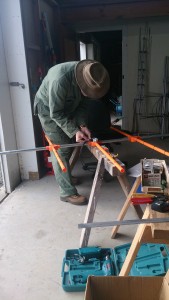Hi there! So since this is my first blog post, I should probably introduce myself before I write anything else.
I’m Ana and I’m currently doing my Honours degree in physics. I have just graduated with a Bachelor of Science, majoring in physics and maths and decided to pursue an academic career in physics.
My project for this year is to detect meteors using forward scattering of radio waves off meteor trails. Instead of building a dedicated radio receiver specific for this project, I decided to use Software Defined Radio (SDR). Basically, this means building an antenna, connecting it to the SDR and setting up a software to detect a radio wave that I normally wouldn’t detect as the transmitter is beyond the horizon. When a meteor enters the atmosphere, it creates a trail of ionised air, the radio wave reflects off this trail, and thus it can be detected.
Since this project was started from scratch, I divided my main goal into smaller goals:
- choose a frequency that I was going to look for
- buy a receiver
- find a computer
- find the software I would use
- build an antenna
- set it all up
- enable remote access to the computer
The system is set up at Ardmore Field Station, in South Auckland so the remote access was necessary so that I wouldn’t have to drive out every day. I had help from a couple of technicians in the physics department with getting the materials for the antenna and with building it, and I had help from IT services when it came to setting up the computer, installing the software and enabling the remote access. At the moment, I am also getting help from my dad with the plugins that had to be added to the software to record the signals, as the currently available plugins online weren’t what I needed.
Here are a couple of progress photos from when the antenna was being assembled:

Putting the elements together

One of the technicians working on the dipole

The dipole

The final set up of the antenna
Currently, as my project stands, I chose the frequency 101.7 MHz from Christchurch, the receiver is Airspy and I am using the software SDR# to detect and record any signals that my antenna picks up at that frequency. So far, I have detected some signals, but these don’t seem to have the power spectrum that a signal that has been reflected off a meteor should have. Based on my readings and what other people have done in the past, there are a few power spectra that I should get depending on how big the meteor is. However, I’m either not interpreting the signals correctly, or these haven’t been reflected off any meteor trails. For reference, please look up “Forward Scattering of Radio Waves off Meteor Trails” by Jean-Marc Wislez, or look at this website since its information mostly came from that research paper.
I started to think that maybe the power at which my frequency is being emitted isn’t strong enough to be detected upon reflection, so I have just tuned into another frequency that’s stronger and I’m waiting to see if my antenna picks anything up. From what I’ve read so far, I’m expecting the biggest meteor count in the hours between midnight and 7am, and the least count should happen in the evening hours (Refer to this website).
The main aim at the moment is to have this whole set up working and detecting by the time the Perseids meteor shower happens, which is only a few weeks away. The peak this year will be at around the 11th of August. I will know that my set up is working if even before the meteor shower I am getting the expected power spectrum, and the expected rate of meteors (most over night and little during the day). The Perseids should be the biggest confirmation of my set up working and it should also be when I collect most of my data to analyse and write about in my dissertation!
I’ll follow up with more posts with updates and/or if I remember anything important I’ve done that I forgot to mention.
Until next time,
Ana








